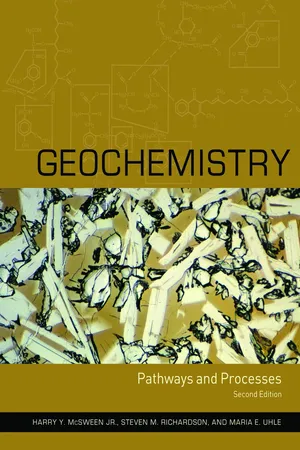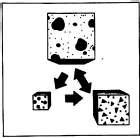![]()
CHAPTER ONE | |
| |
INTRODUCING CONCEPTS IN GEOCHEMICAL SYSTEMS |
OVERVIEW
In this introductory chapter, our goal is to examine the range of problems that interest geochemists and to compare two fundamental approaches to geochemistry. Thermodynamics and kinetics are complementary ways of viewing chemical changes that may take place in nature. By learning to use both approaches, you will come to appreciate the similarities among geochemical processes and be able to follow the many pathways of change. To develop some skills in using the tools of geochemistry, we also examine the limitations of thermodynamics and kinetics, and discuss practical considerations in problem solving.
WHAT IS GEOCHEMISTRY?
In studying the Earth, geologists use a number of borrowed tools. Some of these come from physicists and mathematicians, others were developed by biologists, and still others by chemists. When we use the tools of chemistry, we are looking at the world as geochemists. From this broad perspective, the distinction between geochemistry and some other disciplines in geology, such as metamorphic petrology or crystallography, is a fuzzy and artificial one.
Historical Overview
The roots of geochemistry belong to both geology and chemistry. Many of the practical observations of Agricola (Georg Bauer), Nicolas Steno, and other Renaissance geologists helped to expand knowledge of the behavior of the elements and their occurrence in nature. As we see in more detail in chapter 2, these observations formed the basis from which both modern chemistry and geology grew in the late eighteenth century. The writings of Antoine Lavoisier and his contemporaries, during the age when modern chemistry began to take shape, were filled with conjectures about the oceans and atmosphere, soils, rocks, and the processes that modify them. In the course of separating and characterizing the properties of the elements, Lavoisier, Humphry Davy, John Dalton, and others also contributed to the growing debate among geologists about the composition of the Earth. Similarly, Romé de L’Isle and Réné-Just Haüy made the first modern observations of crystals, leading very quickly to advances in mineralogy and structural chemistry.
The term geochemistry was apparently used for the first time by the Swiss chemist C. F. Schönbein in 1838. The emergence of geochemistry as a separate discipline, however, came with the establishment of major laboratories at the U.S. Geological Survey in 1884; the Carnegie Institution of Washington, D.C., in 1904; and in several European countries, notably Norway and the Soviet Union, between roughly 1910 and 1925. From these laboratories came some of the first systematic surveys of rock and mineral compositions and some of the first experimental studies in which the thermodynamic conditions of mineral stability were investigated. F. W. Clarke’s massive work, The Data of Geochemistry, published in 1909 and revised several times over the next 16 years, summarized analytical work performed at the U.S. Geological Survey and elsewhere, allowing geologists to estimate the average composition of the crust. The phase rule, which was first suggested through theoretical work by J. Willard Gibbs of Yale University in the 1880s, was applied to field studies of metamorphic rocks by European petrologists B. Roozeboom and P. Eskola, who thus established the chemical basis for the metamorphic facies concept. Simultaneously, Arthur L. Day and others at the Carnegie Institution of Washington Geophysical Laboratory began a program of experimentation focused on the processes that generate igneous rocks.
During the twentieth century, the course of geochemistry has been guided by several technological advances. The first of these was the discovery by Max von Laue (1912) that the internal arrangement of atoms in a crystalline substance can serve as a diffraction grating to scatter a beam of X-rays. Shortly after this discovery, William L. Bragg used this technique to determine the structure of halite. In the 1920s, Victor M. Goldschmidt and his associates at the University of Oslo determined the structures of a large number of common minerals, and from these structures, formulated principles regarding the distribution of elements in natural compounds. Their papers, published in the series Geochemische Verteilungsgesetze der Elemente, were perhaps the greatest contributions to geochemistry in their time.
During the 1930s and into the years encompassing World War II, new steel alloys were developed that permitted experimental petrologists to investigate processes at very high pressures for the first time. Percy Bridgeman of Harvard, Norman L. Bowen of the Carnegie Geophysical Laboratory, and a growing army of colleagues built apparatus with which they could synthesize mineral assemblages at temperatures and pressures similar to those found in the lower crust and upper mantle. With these technological advances, geochemists were finally able to investigate the chemistry of inaccessible portions of the Earth.
The use of radioactive isotopes in geochronology began at the end of the nineteenth century, following the dramatic discoveries of Ernest Rutherford, Henri Becquerel, and Marie and Pierre Curie. The greatest influence of nuclear chemistry on geology, however, came with the development of modern, high-precision mass spectrometers in the late 1930s. Isotope chemistry rapidly gained visibility through the careful mass spectroscopic measurements of Alfred O. C. Nier of the University of Minnesota; between 1936 and 1939, he determined the isotopic compositions of 25 elements. Nier’s creation in 1947 of a simple but highly precise mass spectrometer brought the technology within the budgetary reach of many geochemistry labs and opened a field that, even today, is still a rapidly growing area of geochemistry. Beginning with the work of Harold Urey of the University of Chicago and his students in the late 1940s, stable isotopes have become standard tools of economic geology and environmental geochemistry. In recent years, precise measurements of radiogenic isotopes have also proved increasingly valuable in tracing chemical pathways in the Earth.
Advances in instrumentation brought explosive growth to other analytical corners of geochemistry during the last half of the twentieth century. Geochemists made use of increasingly sophisticated detectors and electronic signal processing systems to perform chemical analyses at lower and lower detection levels, opening the new subfield of trace element studies. As we show in chapter 12, this has made it possible to refine our understanding of the evolution of the Earth’s mantle and crust and of many fundamental petrologic processes. The electron microprobe, developed independently by R. Castaing and A. Guinier in France and I. B. Borovsky in Russia in the late 1940s, became commercially available to geochemists in the 1960s. Because the new instrument made it possible to perform analyses on the scale of microns, geochemists were able to study not only microscopic samples but also subtle chemical gradients within larger samples. The 1970s and 1980s, as a result, saw increasing interest in geochemical kinetics.
Finally, as exploration for and exploitation of petroleum became a major focus for geology in the early decades of the twentieth century, the field of organic geochemistry slowly gained importance. In the 1930s, Russia’s “father of geochemistry,” V. I. Vernadsky, was among the first to speculate on the genetic relationships among sedimentary organic matter, petroleum, and hydrocarbon gases. Alfred Treibs confirmed the biological origin of oil in the 1930s. Others, including Wallace Pratt of Humble Oil Company, correctly deduced that oil is formed by natural cracking of large organic molecules and noted that local differences in source material and diagenetic conditions create a distinctive chemical “fingerprint” for each petroleum reservoir. In the latter half of the century, organic geochemists turned their attention to environmental contaminants, redirecting the petroleum geochemists’ methods to trace and control industrial organic matter in soils and groundwater and reconstruct ancient environments.
The growth of geochemistry has been paralleled by the development of cosmochemistry, and many scientists have spent time in both disciplines. From the uniformitarian point of view, the study of terrestrial pathways and processes in geochemistry is merely an introduction to the broader search for principles that govern the general behavior of planetary materials. In the 1920s Victor M. Goldschmidt, for example, refined many of his notions about the affinity of elements for metallic, sulfidic, or siliceous substances by studying meteorites. (You will read more about this in chapter 2.) In more recent years, our understanding of crust-mantle differentiation in the early Earth has been enhanced by studies of lunar samples.
This historical sketch has unavoidably bypassed many significant events and people in the growth of geochemistry. It should be apparent from even this short treatment, however, that the boundary between geology and chemistry has been porous. For the generations of investigators who have worked at the boundary during the past two centuries, it has been an exciting and challenging time. This period has also been marked by recurring cycles of interest in data gathering and the growth of basic theory, to which both chemists and geologists have contributed. Each advance in technology has invited geochemists to scrutinize the Earth more closely, expanded the range of information available to us, and led to a new interpretation of fundamental processes.
Beginning Your Study of Geochemistry
In this book, we explore many ideas that geology shares with chemistry. In doing so, we offer a perspective on geology that may be new to you. You don’t need to be a chemist to use the techniques of geochemistry, just as you don’t need to be a physicist to understand the constraints of seismic data or a biologist to benefit from the wealth of evolutionary insights from paleontology. However, the language and methods of geochemistry are different from much that is familiar in standard geology. You will have to pick up a new vocabulary and become familiar with some fundamental concepts of chemistry to appreciate the role geochemistry plays in interpreting geological events and environments. We start to introduce some of these concepts in this chapter and the next, and introduce others as we go along. As we explore environments from magma chambers to pelagic sediment columns, we hope that your understanding of other disciplines in geology will also be enriched.
As a student of geology, you have already been introduced to a number of unifying concepts. Plate tectonics, for example, provides a physical framework in which seemingly independent events such as arc volcanism, earthquakes, and high-pressure metamorphism can be interpreted as the products of large-scale movement...

